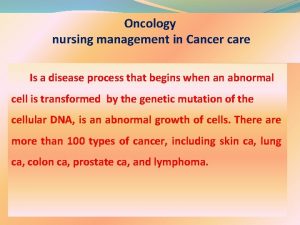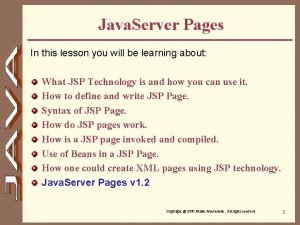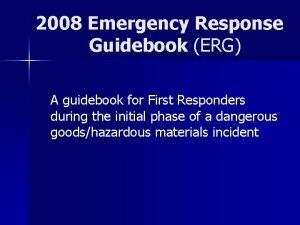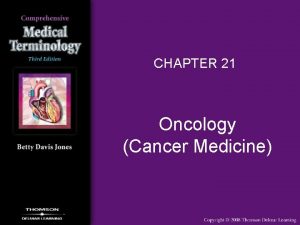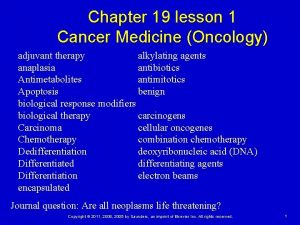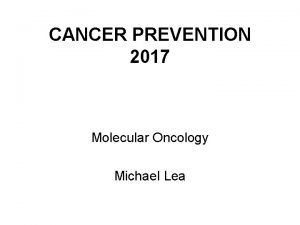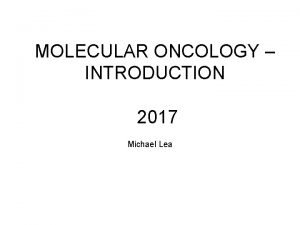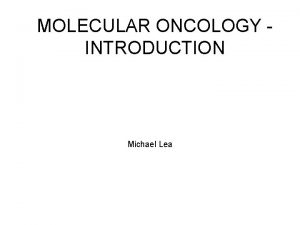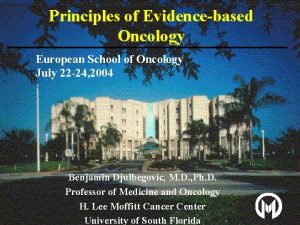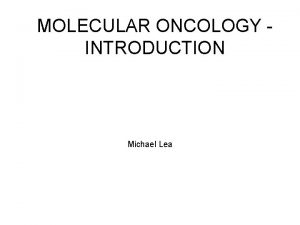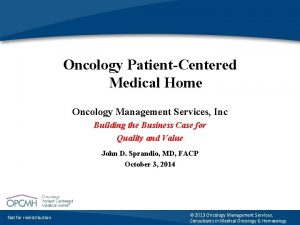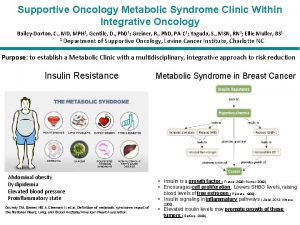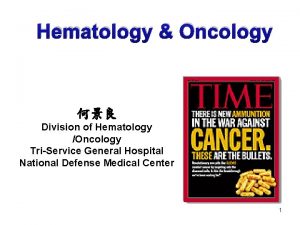Cancer Medicine Oncology Chapter 19 Pages 799 848




































- Slides: 36

Cancer Medicine (Oncology) Chapter 19 Pages 799 – 848

Page 800 Introduction v Cancer = abnormal and excessive cell growth. v More than ½ of all patients who develop cancer are cured. v Most common causes of cancer death: • Women: Lung, followed by breast and colorectal cancers • Men: lung, colorectal, and prostate cancers

Pages 800 – 801 Characteristics of Tumors

Page 801 Characteristics of Tumors (cont’d)

Page 802 What Causes Cancer? v Only partly understood v Malignant v Must transformation = damage to DNA understand DNA and its functions in a normal cell

Pages 802 – 803 v DNA has two main functions in a normal cell.

Pages 803 – 804 Carcinogenesis v DNA mutations lead to higher-than-normal rates of growth or keep them from dying. v Malignant cells are anaplastic. v Carcinogens • Chemicals, drugs, and tobacco smoke • Radiation • Viruses • Oncogenes

Pages 804 Translocation

Pages 804 – 805 Heredity

Page 805 Classification of Cancerous Tumors

Page 806 Carcinomas v This is the largest group • Benign → gastric adenoma = a benign tumor of the glandular epithelial cells lining the stomach • Malignant → gastric adenocarcinoma = a cancerous tumor arising from glandular cells lining the stomach

Page 806

Page 807 Sarcomas v From connective tissues in the body • Benign → osteoma = a benign tumor of bone • Malignant → osteosarcoma = a malignant tumor of the bone

Page 807

Page 808 Mixed–Tissue Tumors v Capable of differentiating into both epithelial and connective tissue. v Uncommon v Examples testes. tumors are found in the kidney, ovaries, and

Pages 808 – 809 Pathologic Descriptions: Gross Descriptions v Cystic v Fungating v Inflammatory v Medullary

Pages 808 – 809 Pathologic Descriptions: Gross Descriptions (Cont’d) v Necrotic v Polypoid v Ulcerating v Verrucous

Pages 809 – 810 Pathologic Descriptions: Microscopic Descriptions v Alveolar v Carcinoma in situ v Diffuse v Dysplastic v Epidermoid v Follicular

Pages 809 – 810 Pathologic Descriptions: Microscopic Descriptions (Cont’d) v Papillary v Pleomorphic v Scirrhous v Undifferentiated

Page 811 Grading & Staging Systems v v Doctors classify tumors on the basis of • Grade: degree of maturity or differentiation under the microscope • Stage: extent of spread in the body These two properties influence the diagnosis, treatment, and prognosis for cancer patient.

Page 812 Cancer Treatment v Major approaches to cancer treatment are: • Surgery • Radiation therapy • Chemotherapy • Molecularly targeted therapy • Immunotherapy

Page 812 Cancer Treatment: Surgery v Many patients with cancer may be cured by surgical excision. v If it metastases, • Dubulking procedure • Then adjuvant (assisting) radiation therapy and/or chemotherapy

Page 812 Cancer Treatment: Surgery v cauterization v exenteration v core v fine needle biopsy needle aspiration v cryosurgery v fulguration v en v incisional bloc resection v excisional biopsy

Page 812 Cancer Treatment: Radiation Therapy v Goal → maximal dose of radiation to the tumor and minimal dose to the surrounding tissue. v Newer techniques

Page 813 Cancer Treatment: Radiation Therapy v Brachytherapy v Electron beams v External beam radiation (teletherapy) v Fields

Page 813 Cancer Treatment: Radiation Therapy v Fractionation v Gray (Gy) v Linear accelerator v Photon therapy v Proton therapy

Page 813 Cancer Treatment: Radiation Therapy v Radiocurable tumor v Radioresistant tumor v Radiosensitive tumor v Radiosensitizers v Simulation v Stereotactic radiosurgery

Page 815 Radiation Therapy Side Effects v Alopecia v Nausea v Fibrosis v Pneumonitis v Infertility v Secondary v Mucositis v Xerostomia v Myelosuppression and vomiting tumors

Page 816 Cancer Treatment: Chemotherapy v Treatment of cancer using chemicals v Chemotherapy may be used alone or in combination v Combination chemotherapy

Page 817 Categories of Chemotherapeutic Agents v Alkylating agents v Antibiotics v Antimetabolites v Antimitotics v Hormonal agents


Page 819 Cancer Treatment: Molecularly Targeted Therapy v Attack specific mutations that drive cancer growth • Cancer cells dies • Not found in normal tissues v Little or no effect on normal cells

Page 819 Cancer Treatment: Immunotherapy v Use of immune cells or antibodies, to kill tumors. Examples: • Modified T cells • Herceptin that blocks a receptor then attacks a growth factor • Nivolumb blocks a protein on tumor cells

Page 826 Laboratory Tests v cytogentic analysis v immunohistochemistry v protein marker tests

Pages 826 – 828 Clinical Procedures v Bone marrow biopsy v Bone marrow or stem cell transplant v Core needle biopsy v Exfoliative cytology v Fiberoptic colonoscopy v Laparoscopy

Pages 826 – 828 Clinical Procedures (Cont’d) v Mammography v PET-CT Scan v Radionuclide scans
 Printed pages vs web pages
Printed pages vs web pages 190 755 799
190 755 799 848 932 2254
848 932 2254 16:9 in pixels
16:9 in pixels Testicular cancer nursing diagnosis
Testicular cancer nursing diagnosis Chapter 2 body structure color and oncology
Chapter 2 body structure color and oncology Chapter 24 the immune and lymphatic systems and cancer
Chapter 24 the immune and lymphatic systems and cancer Chapter 24 the immune and lymphatic systems and cancer
Chapter 24 the immune and lymphatic systems and cancer Yearbook layout design
Yearbook layout design Is a collection of web pages
Is a collection of web pages The lorax worksheet answers
The lorax worksheet answers Jose pages rebollar
Jose pages rebollar What is jsp file
What is jsp file What symbolic number is engraved on montag's helmet?
What symbolic number is engraved on montag's helmet? Day 6
Day 6 Burning bright fahrenheit 451
Burning bright fahrenheit 451 3 pages double spaced
3 pages double spaced House of leaves morse code
House of leaves morse code Fahrenheit 451 pages 93-110 summary
Fahrenheit 451 pages 93-110 summary Emergency response guidebook yellow section
Emergency response guidebook yellow section Pages 294 and 295
Pages 294 and 295 Art research page
Art research page Is the standard page description language for web pages
Is the standard page description language for web pages Fahrenheit 451 pages
Fahrenheit 451 pages Banner admin pages
Banner admin pages Yearbook avenue practice pages
Yearbook avenue practice pages Science fusion landing pages
Science fusion landing pages Eamhttps://inside.amazon.com/pages/default.aspx
Eamhttps://inside.amazon.com/pages/default.aspx Active server pages paradigma
Active server pages paradigma Java server pages life cycle
Java server pages life cycle Https://forms.office.c
Https://forms.office.c Setting of heart of darkness
Setting of heart of darkness Esperanza rising page count
Esperanza rising page count Catcher in the rye poem
Catcher in the rye poem How to write fractions in pages
How to write fractions in pages Citing pages
Citing pages Abnormality pages
Abnormality pages




